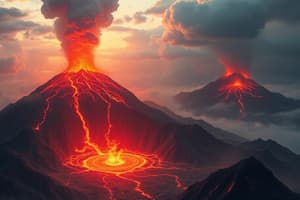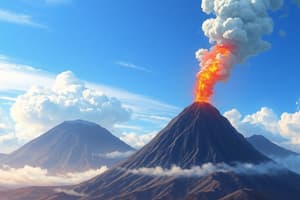Podcast
Questions and Answers
What geological feature is a linear chain of volcanoes that form along the edges of tectonic plates?
What geological feature is a linear chain of volcanoes that form along the edges of tectonic plates?
- Mantle Plumes
- Hotspots
- Subduction Zones
- Volcanic Arcs (correct)
Which geological phenomenon is defined as points where magma rises to the Earth's crust, not directly linked to tectonic plate boundaries?
Which geological phenomenon is defined as points where magma rises to the Earth's crust, not directly linked to tectonic plate boundaries?
- Ring of Fire
- Hotspots (correct)
- Mid-Atlantic Ridge
- Volcanic Arcs
The East African Rift Valley is an example of what geological region known for its active volcanism?
The East African Rift Valley is an example of what geological region known for its active volcanism?
- Mid-Atlantic Ridge
- Pacific Ring of Fire (correct)
- Hotspots
- Volcanic Arcs
Which term refers to a string of volcanoes and sites of seismic activity around the Pacific Ocean edges?
Which term refers to a string of volcanoes and sites of seismic activity around the Pacific Ocean edges?
What causes volcanic arcs to form along tectonic plate boundaries?
What causes volcanic arcs to form along tectonic plate boundaries?
What geological feature is characterized by upwellings of hot material from deep within the Earth's mantle?
What geological feature is characterized by upwellings of hot material from deep within the Earth's mantle?
What is the main characteristic of the Pacific Ring of Fire in terms of tectonic plates?
What is the main characteristic of the Pacific Ring of Fire in terms of tectonic plates?
Where is the Mid-Atlantic Ridge located?
Where is the Mid-Atlantic Ridge located?
What percentage of the world's volcanic eruptions are attributed to the Pacific Ring of Fire?
What percentage of the world's volcanic eruptions are attributed to the Pacific Ring of Fire?
Which region hosts about 450 active volcanoes and is responsible for 90% of the world's earthquakes?
Which region hosts about 450 active volcanoes and is responsible for 90% of the world's earthquakes?
Where does the Mid-Atlantic Ridge separate tectonic plates?
Where does the Mid-Atlantic Ridge separate tectonic plates?
Which region, despite being less active than the Pacific Ring of Fire, still hosts some active volcanoes such as Jan Mayen Island?
Which region, despite being less active than the Pacific Ring of Fire, still hosts some active volcanoes such as Jan Mayen Island?
Flashcards are hidden until you start studying
Study Notes
Distribution of Active Volcanoes: Pacific Ring of Fire, Mid-Atlantic Ridge, Hotspots, Volcanic Arcs
Active volcanoes are a fascinating and important aspect of our planet's geology and geography. They are not evenly distributed around the world, but rather cluster in certain regions. This article will explore the distribution of active volcanoes, focusing on the subtopics of the Pacific Ring of Fire, Mid-Atlantic Ridge, Ring of Fire, hotspots, and volcanic arcs.
Pacific Ring of Fire
The Pacific Ring of Fire is a significant area of seismic and volcanic activity. It is a horseshoe-shaped region around the Pacific Ocean, where about 450 active volcanoes are located. This region is characterized by the convergent boundaries of several tectonic plates, including the Indian, Pacific, North American, and Antarctic plates. The Pacific Ring of Fire is responsible for around 90% of the world's earthquakes and roughly 80% of the world's volcanic eruptions.
Mid-Atlantic Ridge
The Mid-Atlantic Ridge is another region of significant tectonic activity. This underwater mountain range runs through the Atlantic Ocean, separating the North American Plate from the Eurasian and African Plates. While not as volcanically active as the Pacific Ring of Fire, the Mid-Atlantic Ridge does host some active volcanoes, such as the Jan Mayen Island in the North Atlantic.
Ring of Fire
The Ring of Fire is a more general term that encompasses the Pacific Ring of Fire and other areas of seismic and volcanic activity around the world. It is a string of volcanoes and sites of seismic activity around the edges of the Pacific Ocean. The term "Ring of Fire" is often used interchangeably with "Pacific Ring of Fire," but it can also refer to other regions of active volcanism outside the Pacific basin, such as the East African Rift Valley.
Hotspots
Hotspots are points on the Earth's surface where magma rises to the crust, forming volcanoes. They are not directly related to tectonic plate boundaries, but rather are caused by mantle plumes, which are upwellings of hot material from deep within the Earth's mantle. Some well-known hotspots include the Hawaiian Islands in the Pacific Ocean and the Yellowstone Caldera in the United States.
Volcanic Arcs
Volcanic arcs are linear chains of volcanoes that form along the edges of tectonic plates. They are created when the oceanic lithosphere is subducted, or forced beneath the continental lithosphere, creating a zone of volcanic activity. Examples of volcanic arcs include the Andes Mountains in South America and the Cascade Range in the western United States.
In conclusion, the distribution of active volcanoes is not uniform across the planet. Instead, they are concentrated in specific regions, such as the Pacific Ring of Fire, Mid-Atlantic Ridge, and along tectonic plate boundaries. These concentrations of volcanic activity are influenced by a combination of tectonic plate interactions, mantle plumes, and the subduction of oceanic lithosphere.
Studying That Suits You
Use AI to generate personalized quizzes and flashcards to suit your learning preferences.




